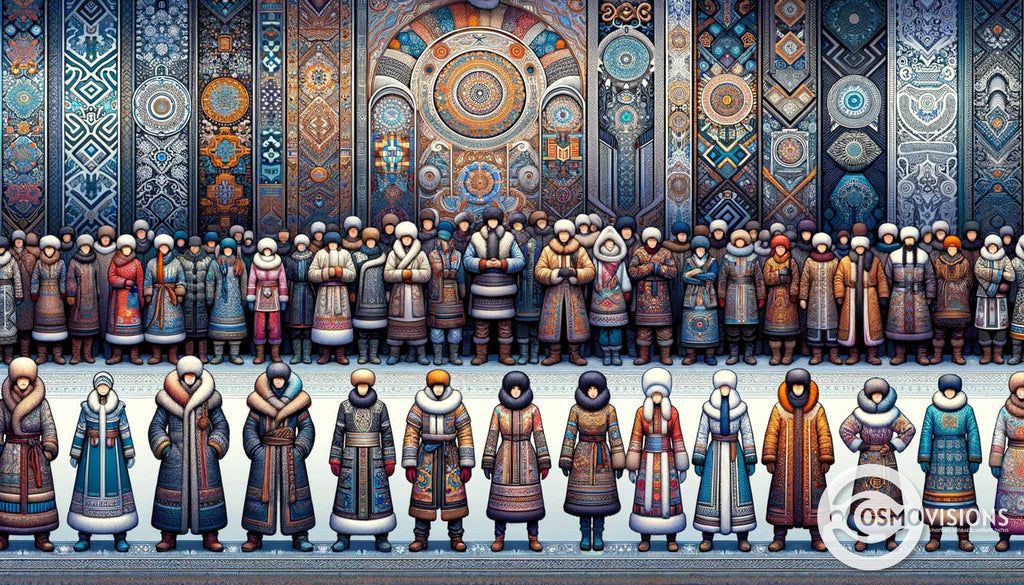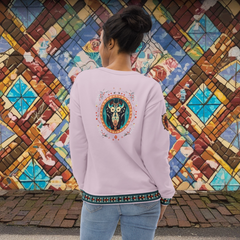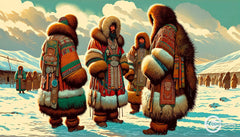The Ultimate Guide To Traditional Yakut Clothing: How To Dress In The Coldest Winter
Posted by Massimiliano Geraci

Winter in Yakutia isn't just a season; it's a test of human endurance. With temperatures that can plummet to minus 60 degrees Celsius, staying warm is not just about comfort—it's about survival.
Many of our readers have expressed curiosity and concern: how does one dress to confront such an unforgiving climate?.
The secret lies in traditional Yakut clothing, designed through generations to beat the world's coldest winters. The artful layering and use of natural materials don't only offer warmth but also embody the culture and resilience of the Yakut people.
This guide will take you through the nuances of their winter attire, offering insights into this remarkable example of human adaptability.
Get ready to unearth the age-old wisdom embedded in every stitch and fur-lined coat—a story told with each piece worn by these hardy souls. Join us as we unravel the secrets to braving Siberia’s brutal cold in style!
The History and Culture of Yakutia
Delve into the heart of Siberia, where the Yakut people have woven a rich tapestry of history and culture against the backdrop of expansive icy landscapes. The resilience of the Yakut society shines through their unique traditions, language, and spiritual beliefs, deeply connected to the natural world that both challenges and sustains them.
Location of Yakutia
Yakutia, a vast and enchanting region, unfolds in the heart of Siberia. It's here where you'll find Yakutsk, clutching the banks of the Lena River as one of its most vital ports. As the world's coldest city, it captures imaginations and compels admiration for those who call it home.
Winter fashion in Russia takes on a new meaning amid this extreme cold weather.
The landscapes are remote and awe-inspiring, stretching across Eastern Siberia with an air that turns breath to frosty whispers. Traditional Yakut attire has evolved not just for style but out of necessity to combat such bone-chilling temperatures.
The arctic clothing includes layers upon layers of heat-insulating materials designed by indigenous knowledge—with survival woven into every thread. This backdrop is a testament to human resilience and offers a glimpse into traditional fashion trends born from necessity rather than mere aesthetics—a combination that draws in lovers of anthropology, spirituality, and art alike.
Origin of the Yakut people
Nestled in the vast expanse of eastern Siberia, Yakutia is not only a place of incredible cold but also the homeland of the resilient Sakha people, or as they are more widely known, the Yakuts.
They carved out a unique identity in this harsh landscape where temperatures plummet to some of the coldest on Earth. The Yakut people trace their lineage back to ancient times and have developed a rich cultural tapestry that reflects their connection with nature and survival instincts.
The early foundations of what would become an ethnic unity under one language shaped life in these extreme conditions. Tradition holds that these ancestors were semi-nomadic, moving with the seasons and adapting to maintain their way of life amid ice and snow.
Their story echoes through the centuries as they transitioned from small family groups into a cohesive society that has kept its traditions alive despite modern pressures. Drawing strength from their shared history and spiritual beliefs, they stand today as proud stewards of an indigenous culture refined by winter's touch – masters in dressing for survival while honoring ancestral ways in every stitch of traditional Yakut clothing.
Yakut language and faith
Delving deeper into the Yakut culture, we explore the Yakut language, a cornerstone of their unique heritage. It's a Northeast Turkic tongue that weaves through everyday life and spiritual practice.
Sacred rituals are often accompanied by chants in this Altaic language, preserving and reinforcing ancient beliefs.
The faith of the Yakut people intertwines animism with shamanistic traditions. Spirits inhabit every part of nature; from rivers to mountains, each is revered and respected. These traditional beliefs guide how they interact with their environment – an integral aspect that shapes both their identity and artistry.
Their spirituality is not just about worship but also acts as inspiration for their vibrant cultural expressions seen in Yakut traditional clothing, jewelry, and other crafts essential to daily life in this frigid landscape.
Traditional festivals
Celebrating the summer solstice, Yakutia bursts with life during Ysyakh, an iconic festival that showcases the region's deep reverence for nature. Participants honor earth's fertility and vitality amid a kaleidoscope of traditional music, dance, and colorful garb rooted in Yakutian spirituality.
The festivities reflect an ancient connection between the people and their environment, expressing timeless joy and respect for natural cycles.
Yakutia also transforms into a winter wonderland where visitors can embrace local traditions through unique experiences like meeting Ded Moroz—the fabled King of Cold—during New Year tours.
This immersive journey into cultural heritage enriches understanding while forging lasting memories. As we transition from festivals to daily attire, let us delve deeper into Yakut clothing essentials designed to weather the coldest winters.

Yakut Clothing, Jewelry, and Arts
Immerse yourself in the rich tapestry of Yakut culture as we explore the intricate designs and profound significance behind their traditional winter attire, jewelry, and arts that are not only visually stunning but also embody a deep connection to an ancestral heritage that thrives amidst the harshest winters.
Traditional winter clothing and its purpose
Traditional Yakut winter clothing doesn't just shield the wearer from bitter cold; it embodies a rich tapestry of culture, indicating one's place in society and affirming their cultural identity.
Picture layers of sustainably-sourced fur and soft hide, each piece meticulously crafted to lock in warmth while offering a window into ancestral craftsmanship. These garments act as personal protective equipment against extreme temperatures, with designs refined over centuries to create the perfect blend of function and tradition.
The purposeful construction of these clothes goes hand-in-hand with reverence for nature and spiritual beliefs. Adorned in heat-insulating clothing such as fur coats that fend off intense winter chill, Yakuts express respect for the animals who provide these materials.
Not merely attire but also symbolic protectors, traditional winter clothes serve dual roles: safeguarding bodies from sub-zero climates and preserving an indigenous way of life through time-honored fashion statements that narrate stories of resilience and adaptation.
Sourcing and materials used
Understanding the purpose behind Yakut winter clothing naturally leads us to explore the resources that make these garments so effective. In creating attire fit for extreme cold weather, Yakut craftspeople turned to the rich natural habitat around them.
They chose animal-derived materials such as fur, hides, leather, and suede not only for their incredible insulating properties but also because they symbolized a deep connection with nature and survival against harsh elements.
These traditional artisans skillfully harnessed local wildlife: reindeer offered thick pelts perfect for heat-insulating clothing; fish skins provided durable yet flexible material.
Their dedication to sourcing authentic, high-quality raw materials ensured that each piece of attire—from cold-protective equipment to winter wardrobe essentials—was both functional and deeply intertwined with cultural identity.
This legacy persists today as modern makers continue using time-honored techniques while honoring the spirit of their ancestors' craft.
Importance of traditional jewelry
Traditional jewelry in Yakut culture carries much more than aesthetic value; it embodies the essence of a rich heritage and personal identity. Silver earrings, artfully crafted with motifs like the Yakutian lilies, are not mere decorations but an expression of symbolism and deep-rooted beliefs.
These cherished adornments highlight ethnic identity while telling stories of history, spirituality, and community ties through their intricate designs.
Embracing traditional silver jewelry allows one to wear a piece of Sakha soul on their sleeve—or rather, around their neck or dangling from their ears. Craftsmen pour tradition into each creation, ensuring that every necklace or bracelet serves as a protective talisman against harsh winters as well as a badge of cultural pride.
For women in Sakha society especially, these ornaments reflect social statuses and connect them to generations past through timeless elegance threaded with pure love symbolized by local lilies.
Yakutian traditional arts
Moving beyond the shimmer of silver jewelry, Yakutian traditional arts are a dazzling showcase of skill and creativity. These masterpieces portray the unique heritage of the region through djabaka, an exceptionally designed winter clothing that doubles as a canvas for artistic expression.
Artisans embroider every inch with vivid beads and threads, transforming functional attire into wearable art steeped in cultural significance.
Crafting such intricate beadwork on women's garments is more than just adornment; it's a visual language narrating stories passed down for generations. Each stitch embodies the endurance needed to thrive in extreme cold weather while retaining grace and beauty.
Embracing these time-honored practices allows wearers to carry forward traditions that survive even in Yakutia’s coldest winters.
Yakutian Traditional Cuisine
Delve into the heartwarming flavors of Yakutian traditional cuisine, where every dish tells a story of survival and celebration in the depths of Siberia's frosty embrace. This culinary journey not only satisfies the palate but also connects you to the ancestral wisdom rooted in each ingredient and technique passed down through generations.
Sticking to traditional foods
Embrace the essence of Yakut cuisine by enjoying dishes that embody the region’s heritage and environmental adaptations. It's a culinary experience where the cold climate dictates a unique diet, steeped in raw or lightly frozen meats and fish—a true reflection of traditional survival strategies.
Wandering through Yakutsk market stalls brimming with frozen delicacies like pork and horse hearts can offer an authentic taste of local life and connect you to centuries-old dietary practices.
Incorporating native ingredients such as dairy, wild berries, meat, and fish into your meals brings you closer to understanding Yakutian culture from the most fundamental perspective—nourishment.
Each bite is an opportunity to savor history, where recipes passed down through generations highlight the importance of conserving cultural identity within modern culinary trends. Engaging with these flavors not only feeds the body but also preserves indigenous knowledge tied deeply to spirituality and artistry intrinsic to Yakutian daily life.
Popular dishes and ingredients
Yakutian cuisine is a testament to the resilience and resourcefulness of its people, with dishes that reflect the extreme climate. Stroganina tops the list, an exotic delicacy made by thinly slicing frozen raw foal meat and liver, often served with spices to enhance its flavor.
This dish captures the essence of Yakut culinary tradition, which is deeply intertwined with survival in harsh conditions.
Essential ingredients like fish and reindeer meat are cornerstones in local recipes, showcasing a deep connection with nature’s bounty. Wild berries add bursts of color and sweetness to meals, creating a harmony of flavors unique to this rugged region.
Dishes such as salamat offer comfort through their rich combination of dairy and bread—a simple yet profound reminder of Yakutia's cultural heritage.
Transitioning from savory delights to cultural immersion, our journey into Yakutian life continues as we explore culinary influences from neighboring regions.
Culinary influences from neighboring regions
Moving beyond the staple dishes and ingredients, Yakut cuisine unveils a rich tapestry of flavors borrowed from surrounding areas. Each borrowed technique or spice serves as a culinary bridge, connecting diners to lands both near and far.
Neighboring regions have shared their gastronomic secrets with Yakut chefs, sparking creativity in local kitchens. These exchanges add diverse notes to traditional recipes that are as robust as the regional connections they embody.
Cherished recipes tell tales of cultural exchange through every bite, where hints of distant herbs mingle with indigenous meats. The artful fusion on the plate mirrors Yakutia's own history—a landscape shaped by external influences yet distinctly its own.
This intermingling gives rise to innovative menus that honor ancestral roots while celebrating new culinary friendships.

Tips for Experiencing Yakut Culture
Dive deep into the heart of Yakutia by engaging with its rich traditions; immerse yourself in vibrant festivals, and embrace local customs to truly experience the cultural tapestry of this unique region.
Participating in traditional activities
Engage directly with Yakut culture by taking part in traditional activities that celebrate their time-honed customs. Dress in the layers of cold-protective clothing unique to this indigenous group and feel the spirit of their ancestors as you join local festivities or ceremonies.
Participation goes beyond mere observation; it's about immersion, learning how to move and stay warm in extreme cold weather attire while embracing community values.
Discover the joy and communal connection found in donning Yakutian style for dances, songs, and storytelling events. Every stitch of heat-insulating clothing has a story to tell – from survival against harsh winters to expressions of faith and identity.
As an anthropology enthusiast or spiritual seeker, attending these culturally rich occasions presents an opportunity to witness first-hand how clothes are not just garments but pieces of living history passed down through generations.
Visiting during festivals
After immersing yourself in traditional activities, consider planning your visit to coincide with one of Yakutia's vibrant festivals. These events offer a unique window into the soul of Yakut culture, showcasing everything from folk dances to elaborate ice sculptures.
Marvel at the craftsmanship and detail that go into creating these frozen masterpieces in Yakutsk, which become a focal point for visitors from around the world. Each festival is a celebration of resilience against the cold and an homage to tradition—a perfect opportunity for anthropology enthusiasts and art lovers to gather under one sky.
Exploring Yakutia during festival times allows you to experience layers beyond just cold weather clothing and heat-insulating apparel; it’s where cultural pride radiates even amidst extreme temperatures.
Stand shoulder-to-shoulder with locals donning their indigenous dress, witness time-honored ceremonies, and partake in feasts that typify Yakutian hospitality. Such encounters are not merely spectacles but participatory experiences where each visitor can connect more deeply with the spirit of this remarkable region.
Support for educators and students interested in Yakut culture
Educators and students diving into the rich depths of Yakut culture find a treasure trove of knowledge in traditional dress and spirituality. They can explore how Sakha traditional clothing beautifully mirrors the wide environment, capturing not just style but also survival tactics against the harsh winter.
As they delve further, insights into religious beliefs tied to these garments reveal a fascinating tapestry of Yakutian life.
For those teaching or learning about this unique way of living, numerous resources shine light on the intersection of climate, culture, and costume design. Understanding Yakut winter clothing goes beyond fabric— it's an immersion into history and heritage that shapes how people withstood extremes while maintaining their identity.
These educational journeys enrich curriculum and personal growth alike by showing the practical benefits intertwined with cultural pride.
Recommended books and resources for learning more about Yakutia
Delving deeper into Yakut culture goes beyond events and festivals; it also involves immersing yourself in literature that captures the essence of this unique region. Explore a wealth of knowledge through books like "Yakutia: The Land of Hidden Treasures" for vivid narratives about the traditions and lifestyles or "The Sakha Republic's Ethnography," which offers an academic perspective on Yakutian customs and heritage.
For visual learners, photo collections such as "Yakutia Through the Lens" can paint a breathtaking picture of traditional attire, jewelry, and landscapes.
Online platforms are treasure troves for contemporary insights and historical perspectives essential to understanding Yakutia's spiritual depth and artistic flair. Websites dedicated to indigenous cultures feature articles, interviews with local artisans, detailed analyses on thermal insulation in clothing design, and discussions about faith practices.
These resources provide ongoing updates on Yakut community life while supporting further exploration into their rich culinary arts, language evolution, and influence on cold weather fashion globally.













